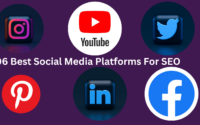Functionality of Social Media and SEO
In this article, we explain many unique facts and the functionality of social media and SEO. Read this article in full to know more about it.
Social media & search engines are often used concurrently in web sessions, both formal SEO and social SEO are essential parts of your entire social SEO strategy. Integration of social media and SEO makes perfect sense. A social media SEO strategy can assist your business in developing deeper relationships with customers, optimizing your content to faster than predicted in search engine results pages (SERPs) and on social media, and better reaching your audience where they spend the most time.
According to the rankings of Search Engine Journal’s most famous international search engines for 2022 are Facebook, YouTube, Instagram, Twitter. It is easy to look for recommendations, posts, hashtags, and content on these sites in the same way that you do on search engines.
Social media can also have a significant impact on your Google search engine rankings. People engaging with your content on social media can expand its reach and help you move up in search engine rankings. Social media cues can also be used to notify your SEO strategy. After all, social media is where everyone spend the majority of their free time. Focusing to what audiences are saying about your brand and how they interact with it provides valuable insights into how to improve your website content.
Google’s approach to the Functionality of Social Media and SEO
Google does not clearly say social signals are using for ranking in its search algorithms. But in SEO, social signals indicate how well your information gets involved with social media users.
Among the social ranking factors are:
- The number of times a website is shared on social media platforms.
- The number of times a website has been “liked” or interacted with via social media.
- The viewed reach and presence of your website on social media.
There’s a search engine such as Bing. It only accounts for about 6.79% of the global desktop search engine market. Bing has stated unequivocally that it uses social signals to determine search results. The search engine Bing has stated in its Webmaster Guidelines that social media influence plays a role in search result displays. Social signals indicate that company website content is widely shared by followers, which the search engine has factored into its relevance algorithm.
It is safe to say that social media engagement has an impact on search, even if it is not explicitly stated. Google has frequently changed its mind about algorithm factors over the years. So we can assume that it may pivot on social signals in the future as well.
Learn about integrating social media and SEO

01) The number of users of a high-quality website increases daily. Therefore, to improve the ranking of your website, you need to increase the number of users. For that there should be high social media engagement. For this, quality content will help you to win in social media as well as in SEO.
02) Users who interact with your brand’s website and share it on social media expose it to more users. Then your content will be shared among many people. This increases potential search algorithm factors such as page views, time spent on page, pages visited on your site, bounce rate, etc..
03) The more people interact with your brand and share it with their followers on sites like social media, the more likely you are to gain others’ trust and authority in your industry. The concept of trust and authority improves your relevance in search results.
04) High quality content with more users interacting with social media has a longer shelf life. Long-lived content improves the durability of your website. This will serve as a powerful lead generation tool for your company and will be something that can be shared for years to come.
05) Through channels like social media, your brand reach increases. The more brands you have on your website, the more likely others will link their own high-quality sites to your site. High quality backlinks help you climb the rankings. This is a very good form of advertising.
06) A website with high-quality content naturally gets more traffic, which helps increase search engine appeal. When people share your content through social media, this organic traffic takes your brand to the next level. And it appears at the top of search engines.
How to incorporate social media into your SEO strategy

Usually any company appoints a separate department or officer for media work. If not, it’s better to do it that way. Such large companies employ social media experts, copywriters, graphic designers, social content creators, etc. You may also have SEO experts monitoring your analytics and webmasters ensuring your development team is optimized for users.
But you may find it difficult to maintain such a large media or social media SEO team. But there are different ways to make your work more efficient and effective. Below are some suggestions to help you make this work, especially through silent groups sharing cooperation and understanding.
Improve your brand’s visibility across all digital channels.

People use social media to build connections with brands, receive customer support, and socialize with friends. Websites provide information, guide users through a journey, and provide useful content.
Ideally, you want your website’s and social media pages’ fans and visitors to develop in tandem. It is critical to ensure that your brand experience is consistent across all of your online platforms, such as social media. Here’s what we recommend for effective social SEO.
Recommendations for you:
- Add social information to your website as needed. Insert YouTube videos for item tutorials, for example, on your shopping sites. You could request permission from social media followers to use their personal testimonies on your website.
- List social media platform icons on every website page so that visitors can easily visit as well as follow you. Allow social sharing of your website’s content by including buttons such as “Facebook Share” or “Tweet This.”
- Make sure your contact information on all social media sites includes a link to your website. It’s especially important for local businesses to have exact location, town, country, ZIP code, and contact information.
- Use user-friendly language to promote information from your website on social media sites.
- Fill out all of the social media information forms for your profile. The more relevant keywords you include in your account, the more likely you will appear in search engine results on the social media site as well as possibly in search engines.
Remember that when someone searches for your company, your social media pages may appear in Bing, Google, or other search engine results. Use the same advertising best practices for social media as you would for your website, so that what users see on social media accurately represents your brand.
Investigation and testing

All your official site SEO data and the social media data provide a plethora of information that can assist both teams in making better decisions. The following methods for research and testing can assist in improving a social SEO strategy.
Methods :
- Use social analytics to help guide your content strategy. When you see previous content that has done very well social media, you can build on it by attempting to create new blog posts or videos which you can share on social media, and so on.
- Examine your site’s best-performing web pages. In your social media content calendar, highlight those with information and calls to action that are appropriate for each platform. Use social media to reach out to new audiences.
- Pay attention to social media conversation. How are your followers discussing? What topics pique their interest? Use these insights to improve the content on your website.
- For social media content, conduct SEO keyword research. Add keywords that you rank for in search engines to your social media content to improve your awareness in social media search engines. To inform usage, some platforms, such as Conductor, incorporate social mentions into query research. Then you can tailor queries to consider the tone of your social channels, potentially broadening the ways people find the content they seek.
- Product and service advertisements should be tested. You can apply data from social media engagement to other advertising campaigns, such as paid advertising. Products and services that aren’t performing well can benefit from a promotional boost on social media.
- On the website, you can track social referral journeys. Examine how social media site visitors engage with your website. Do they interact with specific pages or products? Do they tend to abandon certain pages? All such observations can assist you in better comprehending your social media followers and the user experience on your website.
When your exploration and social teams function in silos, you expend valuable time and resources because each group has data that can help the other but isn’t sharing that data. Gather to share reports, data, insights, techniques, and test results in order to work more efficiently.
Utilize social media discussions to increase organic traffic.

Google is supplying responses to users’ search queries straightforwardly in the search engine, without the need for clicks, via result types such as featured snippets. Listening in on social media conversations is one way to address this issue and gain organic traffic.
In general, as topics and hashtags gain popularity, so do connected search keywords and the number of results displayed. When you discuss those topics on your website, such as in a blog post, you can capitalize on current search intents.
Also you can get online tools to track your own brand mentions in social media conversations as well as chatter on your own social media channels. Use social listening tools to see what is popular with social media users across platforms in general.
Then, you can incorporate those insights into your website copy, blogs, and other content. By aligning keywords in your content with popular social media chats, you can directly communicate with the audience you want to reach.
The most effective technique for optimizing content for social media

When social media users link to your content on their own websites, it can be a powerful link-building tool. Everything begins with high-quality website content.
- Make content that your fans desire to click on, interact with, and share. In-depth research is essential. You must understand your target audience, which will vary depending on the social platform.
- Use best SEO practices. This includes having meta – data, optimizing the copy for high MSV keywords, and continuing to focus on user-friendly content.
- Give your target customers useful, relevant information. Instead of selling to customers, concentrate on creating valuable content that assists them.
- Convert content into visually appealing or interactive social visuals. The final step is not to create a caption. Focus on designing social visuals that summarize the content in a manner that stands out in users’ newsfeeds so that you can capture their attention.
Effective link building begins with the user experience of the website. Your webpage should be simple to use on all devices. It should be simple and easy to use, giving users with the precise information they seek and require. A website that is useful to your target leads and clients is more likely to share on social media and rank higher in applicable search queries. If your website is not optimized for search, it is unlikely to perform well on social media.
Furthermore to a user-friendly official site, you can improve the effectiveness of your social media efforts by creating content that your clients want to engage with. Using customer profile, you should be able to determine which channels your leads as well as customers spend the most time on. You should also investigate whether they prefer to watch videos, read long-form blog posts, scroll through slides, or consume other types of social media content.
Consult with your social media team once more to determine what kinds of content is the best for your company website pages and those of other competitors. Try to use social listening to know competitor social media performance and apply what you learn to your own strategy and content creation.
Make every content familiar to social media as well. Include social sharing buttons in each post.
Enable commenting that compel a social media login. Users may return to a article with many comments or that sparks debate frequently to revisit comments. More pageviews may also lead to increased engagement with your website as a whole.
Recommended :


